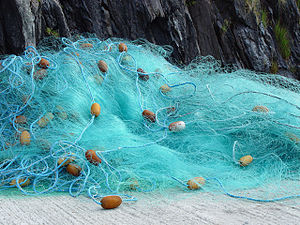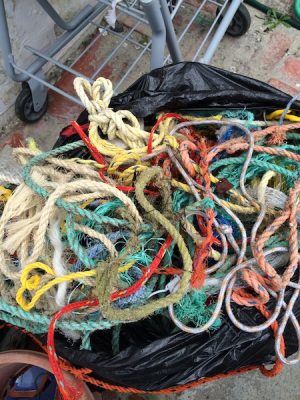Countries agree on international guidelines to mark fishing gear – final step is endorsement by Committee on Fisheries

February 2018, Rome – In a historic decision, countries agreed on a set of draft Voluntary Guidelines on Marking Fishing Gear taking a big step forward towards cleaner seas and safer navigation. It is expected that the guidelines will receive final endorsement by FAO’s Committee on Fisheries (COFI) in July 2018.
Made predominantly of plastic, fishing gear, when abandoned, lost or discarded at sea, is a significant component of marine debris and has been a concern of FAO Members for decades. Approximately eight million tonnes of plastic litter, up to ten percent of which is estimated to come from the fisheries sector, ends up in our oceans every year.
These guidelines will help countries to develop effective systems for marking fishing gear so that it can be traced back to its original owner. Doing so will support efforts to reduce marine debris and its harmful impacts on the marine environment, fish stocks, and safe navigation. It will also allow local authorities to monitor how fishing gear is being used in their waters and who is using it, which makes them an efficient tool in the fight against illegal, unreported and unregulated (IUU) fishing.
“Appropriate marking is an effective tool for improving overall fishing gear management, preventing abandoned, lost or otherwise discarded fishing gear, facilitating its retrieval and potentially identifying illegal fishing operations”, said Árni M. Mathiesen, FAO Assistant Director-General for Fisheries. 
Unacceptable levels of plastics in oceans
Fishing gear is often lost through uncontrollable circumstances – such as storms or accidents – or because there are no adequate facilities at ports for the reception of fishing gear. However, sometimes fishing gear is also dumped by vessels engaged in illegal, unreported and unregulated (IUU) fishing in the hope of evading detection.
Over time, fishing nets left in the ocean may break down into microplastic pieces, which become accessible to a wide range of organisms including small fish and plankton, and may cause serious toxicological harm to marine wildlife.
Considering the unacceptable levels of fishing gear debris in oceans, the global fishing industry and governments have recognized the urgency to address the issue across all relevant sectors, including the environment, fishery management and regulation.
Dangerous fishing nets
Abandoned, lost or discarded gear can continue to “ghost fish” even when it is no longer under the control of humans. This can have serious detrimental impacts on fish and other marine organisms that become entangled in these nets, often unable to escape.
Ghost gear poses serious safety concerns to navigation too. Recent studies in the Republic of Korea indicate increased incidences of ships’ propellers becoming entangled in abandoned fishing gear. Some of these incidents have led to serious accidents, including the capsizing of a passenger ship where 292 people lost their lives.
Building capacity to meet new standards
The Guidelines are global in scope, but countries recognize that making them work for small-scale fisheries in developing countries will require additional support to meet the new standards. For example, ports in many countries still do not include reception facilities for disposing of fishing gear. In other cases, where port reception facilities exist they are not free of charge and small-scale fisheries cannot afford using them.
Modern technologies such as satellite buoys or GPS receivers make it easier to detect the lost fishing gear but it could be too expensive for the majority of small-scale fisheries to remove them.
The guidelines make it clear that the level of complexity of the gear marking should be based upon local conditions and needs. FAO has already started a number of pilot projects to address these issues.
In Indonesia, for example, FAO works alongside the Indonesian government and partners in the Global Ghost Gear Initiative, to introduce fishing gear marking in small-scale fisheries communities. The project works directly with local fishing collectives using gill nets, which are a very high risk gear type for marine debris. Initial feedback from the communities participating in this pilot project has been positive, as gear marking is viewed as an effective tool in achieving better fisheries management that benefit the communities.
Contact
Irina Utkina
FAO Media Relations (Rome)
(+39) 06 570 52542
irina.utkina@fao.org
